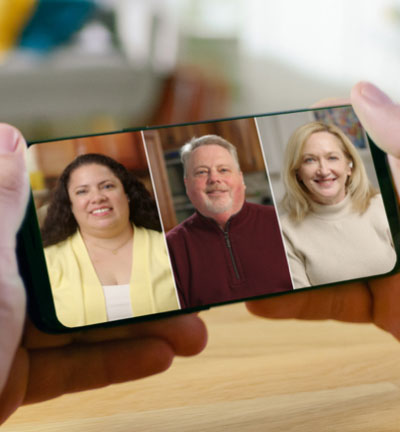Want to help your loved one aim for greater symptom management? Try these tips.
Being a myasthenia gravis (MG) supporter can sometimes be a balancing act. You want to support your loved one but may not always know how, all while trying to care for yourself as well. One of the trickiest parts about supporting a loved one with MG is trying to understand what they’re going through, and part of that is recognizing the fluctuations in symptoms they may experience.
However, you can play an important role in helping them track their symptoms to aim for better symptom management. Not only can this help you learn more about what they’re dealing with, you might be able to notice certain symptoms or changes before they do. The more you can help your loved one track their symptoms, the more you may be able to understand how MG affects them. Plus, this can put you in a better position to help them advocate for themselves with their healthcare team and pursue their goals for a greater everyday with MG.
Keep reading for tips from MG supporters on how they’ve navigated this journey.
Knowing MG goals and monitoring progress
In order to best support your loved one, you’ll want to make sure you know their specific goals with MG management. What did they love doing before MG that’s not as easy now? Which abilities are most important to them to get back to? You can be that extra set of eyes and ears to gauge whether symptoms are becoming too burdensome for them to get closer to those goals. Take this quiz with your loved one as well to help them see if there’s room to aim for greater symptom management.
Mary,* whose husband, John, lives with MG, is very in tune with John’s goals. “He loves to garden and work outside, so he wants to have the energy and endurance to do so. We also have grandchildren who are small, so keeping up with them is a goal,” Mary shared. “John also loves sports, especially playing tennis. I support him by being there if he needs me, reminding him to hydrate and stretch, for example.”
It's important to recognize that as MG symptoms fluctuate, MG goals may evolve with them. Jerry,* whose wife lives with MG, mentioned how his wife's goals right after diagnosis were much different than what they are now, and how they intentionally took baby steps to get here. When she was first diagnosed, a goal was to be able to swallow a drink properly. Today, she and Jerry want to get back to some of the social activities they were able to enjoy before MG, and they’re starting to do so. Recently, they were able to get together with friends, enjoying a late night out at a rooftop bar with a nice dinner—something they couldn’t comprehend doing 10 years ago.
Speaking up about symptoms you notice
While the person living with MG knows best what they are experiencing, there may be things that an MG supporter can spot more quickly. For example, Jerry noted how droopy eyelids and slurred speech are symptoms he tends to notice in his wife more than she does, as she’s not always able to see or hear herself in the way that he can. He also thinks it may be more difficult for the person living with MG to observe every symptom, since they’re the ones personally dealing with the frustrations of it every day. “When a person reaches that new normal, they may not recognize some of those things that they may not want to think about since they have this chronic condition,” Jerry said.
Mary mentioned noticing eyelid droop in John as well, but she has also noticed fatigue and breathlessness, particularly when he is doing a repetitive motion like using tools to cut shrubbery. Communicating these observations to loved ones can understandably be challenging for MG supporters, finding a way to be direct yet sensitive. “I never want to say anything that would cause him to be self-conscious,” Mary said. “If I think the symptom can be helped, I try to introduce the subject in a questioning way rather than making a statement.”
Similarly, Jerry says he has learned to be more aware of his tone when broaching the subject, acknowledging that minor nuances in speech can cause a well-intended statement to be misinterpreted. Watch this MG Real Talks roundtable discussion to hear from more MG supporters on how they communicate mindfully and empathetically with their loved ones about MG.
I’ve found that when we work on things together, he’s much more encouraged to do things that will help him in the long run.
Symptom-tracking methods
In addition to communicating what you observe to your loved one, find ways to document these symptoms together to help them prepare for doctor appointments. Mary keeps a journal of John’s symptoms and also keeps notes on her smartphone—John has started to join her in the latter, tracking symptoms on his smartphone as well. “I’ve found that when we work on things together, he’s much more encouraged to do things that will help him in the long run,” Mary explained.
Jerry texts himself when he notices his wife’s symptoms so he can have a time stamp that may help associate any triggers, based on what they were doing at that time that day. He occasionally takes pictures to help document the surrounding details as well.
A symptom-tracking tool you can use with your loved one is the Myasthenia Gravis Activities of Daily Living (MG-ADL) scale, which helps identify the impact MG has on daily life by assessing the severity of the symptoms. Not only can this tool help you understand what your loved one is going through, it can help their healthcare team better understand too, as many doctors are familiar with this scale.
The scale includes eight daily activities related to common MG symptoms, each of which is measured on a scale of zero to three, with a score of zero representing normal function and a score of three representing the greatest severity of symptoms. The total score can range from zero to 24 points—in general, the lower the score, the less one’s daily activities may be impacted.
Being an advocate at healthcare appointments
It’s important for people living with MG to feel empowered to advocate for themselves at doctor’s appointments, but having a loved one there with them may also be beneficial. To help make sure the appointment is productive with both of you there, discuss your roles beforehand. Will you take notes for your loved one? Would they prefer you take the lead on certain topics? Both Jerry and Mary attend healthcare appointments with their spouses and feel they have a significant role, particularly in helping identify symptoms that have been occurring.
“We accept that we are going through this together,” Mary shared. “I try to be there as support, to simply remind him of difficulties he may have forgotten to mention and also to bring attention to the positives.”
Don’t underestimate the value of your role as an MG supporter. Use the tips from this article to keep helping your loved one manage their MG in a way that helps them get closer to their goals. And, just as importantly, remember to practice self-care to help prevent caregiver burnout. Caring for yourself is a key step to ensuring you can care for someone else!











